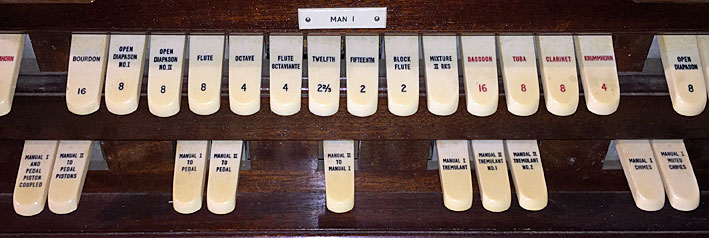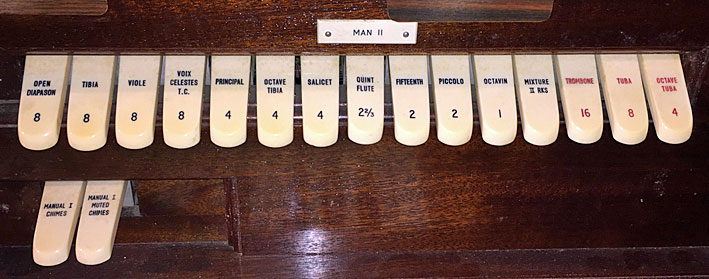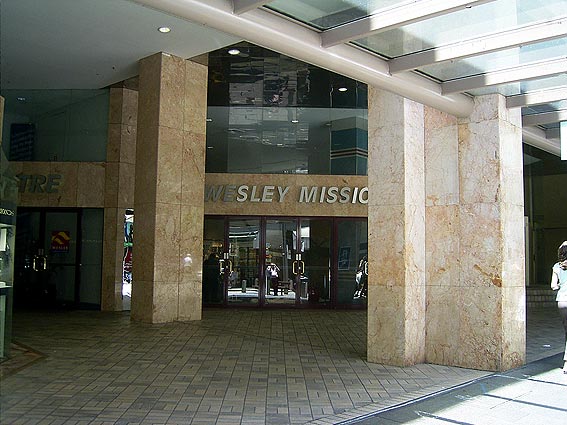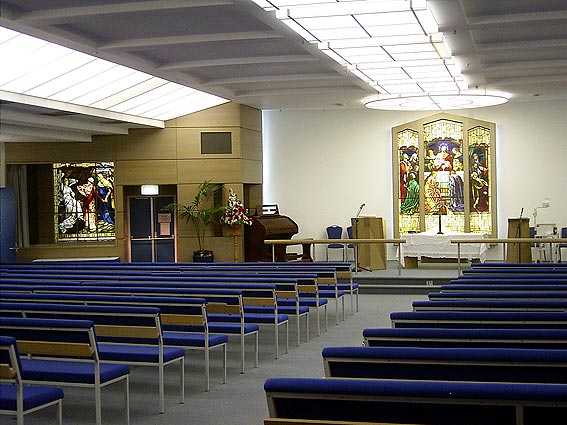Built by Whitehouse Bros. Brisbane 1941-2
Rebuilt by Pitchford & Garside, Sydney 1991
It was acquired in 1991 from the Christian Science Church, Chatswood (original building)
(2/17 electric)
| Great Open Diapason Stopped Diapason Dulciana Octave Flute Twelfth Fifteenth Swell Violin Diapason Gedact Salicional Principal Nason Flute (from tenor C) Mixture Trompette Tremulant Pedal Bourdon 16' Bass Flute 8' Octave Flute 4' |
8 8 8 4 4 2-2/3 2 8 8 8 4 4 III 8 16 8 4 |
A A A |
Accessories
Great to Pedal
Swell to Pedal
Swell octave to Pedal
Swell to Great
Swell octave to Great
Swell suboctave to Great
Swell octave
Great and Pedal pistons coupled
3 divisional pistons for Great
3 divisional pistons for Swell
3 toe studs for Pedal.
Compass 61/30
Detached console
No organ façade
Specification supplied by Michael Taylor 2005


Organ chamber
Wesley Theatre

The organ chambers are on the left above the seating.
The console is kept on a moveable platform backstage.
"Christie" theatre organ by Hill, Norman & Beard 1928,
reb. HNB (1965), rem. and reb. Pitchford & Garside 1991
(2/8 ranks extension plus Mixture)
1905: An organ by George Fincham (1888) was installed from the Centennial International Exhibition, Melbourne (3 manuals, 42 speaking stops, tubular-pneumatic action) in the Lyceum Hall, Sydney. This organ had been installed in the Masonic Hall, Melbourne in 1889 and was subsequently sold in 1905 to Ebenezer Vickery MLC for installation in the Lyceum Hall which he donated to the Central Methodist Mission in 1908. This was the third largest organ built in 19th century Australia – the two that were larger were at the Exhibition Building, Melbourne (1880) and at the Australian Church, Melbourne (1890) both by the Fincham firm. It was a remarkable example of late nineteenth-century organbuilding in conservative Romantic style. While its sound is now beyond recall, the specification, with its well-developed Diapason ensemble (including the Pedal division with Principals at 8', 5-1/3' and 4' pitches) clearly reflects the classical outlook of conservative English builders like Hill & Son, who, in turn, had been influenced by the North German eighteenth-century organ.
).jpg)
The Lyceum Hall at the time opening on 12 April, 1908 after renovations
(The Uniting Church Archives: The Methodist, Saturday 18 April 1908)
-(Uniting-Church-Archives;-The-Methodist-18-April-1908).jpg)
The Lyceum Hall at the time opening on 12 April, 1908 after renovations
(The Uniting Church Archives: The Methodist, Saturday 18 April 1908)
-(Uniting-Church-Archives;-The-Mehodist-18-April-1908).jpg)
The Lyceum Hall at the time opening on 12 April, 1908 after renovations
(The Uniting Church Archives: The Methodist, Saturday 18 April 1908)
Quotes from The Methodist relating to the Hall/Theatre, as researched by Robert Parkinson (Dec 2018 from the Uniting Church Archives):
Sat 17 June 1905, P8 – "Through the kindness of the Hon E Vickery, it has been arranged that a service shall be held every Sunday evening in the Lyceum Theatre. The services already held have been remarkably successful. Upwards of 1220 people were present last Sunday evening, and this has not in any way affected the attendance or the offering at the Centenary Hall."
Sat 24 Aug 1906, P8 – [Obituary of Hon E Vickery] "… the death of the Hon E Vickery MLC, in England on Monday last [20 August] …. The purchase of the Lyceum Theatre and adjoining property, and its dedication to spiritual and social work, is the crowning glory of Mr Vickery's intense desire to bring the blessing of salvation and help …"
Sat 17 Aug 1907, P2 – brief description of planned renovations [no mention of organ].
Sat 4 April 1908, P2 – [Inspection of renovated Lyceum Theatre] "The interior decorations of the old order have been removed, and we could not help thinking that the other extreme of plainness has been reached ….. testing the 'seeing' capabilities from different points up to the top gallery …. The buildings cover the whole of a block 300 feet deep, facing two of the leading thoroughfare of the city, with a frontage of 68 feet to Pitt Street, and 96 feet to Castlereagh Street. In the former street the buildings rise to seven stories from the pavement, with a basement under the street level. Those of the latter to a height of five stories, surmounted by a clock tower …. the large central hall … is certainly one of the finest auditoriums in Australia, comfortably seating 2500 people ….. Magnificent organ placed in old hall by Hon E Vickery has been brought down fifteen feet and has had an electric blower attached to it."
Sat 11 April 1908, p2 – "Farwell to York Street …. Rev W G Taylor's sermon at the Centenary Hall last Sunday night, upon the occasion of saying farewell – so far as Sunday services are concerned – to the historic York Street site …. Macquarie Street died to give birth to York Street, York Street to the Centenary Hall; and now this hall passes away to make room for a greater and better furnished home in which [to preach] …. A Reminiscence. A musical friend forwards us the following extract from the 'Musical Times,' dated April 1, 1869: Sydney – the new organ built by Mr Jackson was inaugurated on the 15th December last, by an entertainment at the York Street Wesleyan Church. Haydn's 'Creation' formed a fitting test for the powers of the organ …. its powers were fully tested by Mr Packer, whose performance of the introduction 'Chaos,' and the musical representation of 'Morning,' was entitled to much praise."
Sat 18 April 1908, P2 – Opening on Sunday 12 April 1908 of renovated Lyceum theatre purchase by Mr Vickery and now to be known as the Lyceum Hall.
The specification of the 1888 Fincham organ was:
Lyceum Hall, Sydney (1888 Fincham organ)
| Great Double Open Diapason Open Diapason Loud Gamba Clarabella Octave Wald Flute Twelfth Fifteenth Mixture Posaune Clarion Choir & Solo (enclosed) Dulciana Gamba Voix Celeste Lieblich Gedact Flute Harmonique Clear Flute Piccolo Harmonique Bassoon Clarionet Orchestral Oboe Vox Humana Oboe Clarion |
16 8 8 8 4 4 3 2 3 ranks 8 4 8 8 8 8 8 4 2 16 8 8 8 4 |
Swell Gedact Geigen Principal Gedact Salicional Gemshorn Rohrflöte Piccolo Mixture Cornopean Oboe Clarion Pedal Sub Bass Open Diapason Bourdon Principal Bass Flute Twelfth Fifteenth Trombone 12 couplers Tremulant 13 thumb pistons Tubular pneumatic action |
16 8 8 8 4 4 2 3 ranks 8 8 4 32 16 16 8 8 6 4 16 |
1928: The Fincham organ was removed and broken up and replaced by a 9-rank Christie (Hill, Norman & Beard) organ
The basic nine ranks of the Lyceum organ were:
- Violone
- Bourdon
- Open Diapason I
- Open Diapason II
- Tibia Clausa
- Celestes
- Tuba
- Clarinet
- Vox Humana
The sepcification below, shows the extent to which these stops were extended, providing also the list of percussions. It is important to note the wide range of accessories provided for ease of control. The "second touch" device was an unusual innovation: this device allows one set of registrations to sound when the keys are played to half the normal depth, and a second set to sound when the keys are fully depressed. Such an organ was not obtained cheaply: the figure of £5,000 was more than double the amount paid for the Strathfield Methodist organ, which had more than three times the number of pipes, but considerably fewer accessories and special effects.
With the advent of "talking" movies in 1929, the utility of the scheme belowwas reduced, although the instrument continued to be used for the accompaniment of hymns, solos and choral music in mission services.
Lyceum Hall, Sydney (1928 Christie organ)
| Accompaniment Violone Open Diapason I Open Diapason II Tibia Clausa Viol d'Orchestre Celestes Octave Principal Tibia Gemshorn Twelfth Fifteenth Piccolo Vox Humana Tuba Clarinet Vox Humana Vox Humana Chrysoglott (37 notes) Snare Drum roll Chinese block reiterating Tom Tom Castenets Triangle Tambourine Pedal Acoustic Bass Diaphone Violone Bourdon Octave Bass Flute 'Cello Piccolo Tuba Bassoon Solo to Pedal Couplers Bass Drum Tap Cymbal Tap Kettle Drum Snare Drum Roll Tolling Bell Triangle Chimes |
16 8 8 8 8 8 4 4 4 4 3 2 2 16 8 8 8 4 32 16 16 16 8 8 8 4 8 8 ) ) ) ) ) ) ) |
1st touch " 2nd touch " " " " |
Solo Diaphone Violone Bourdon Open Diapason I Open Diapason II Tibia Clausa Viol d'Orchestre Celestes Principal Octave Geigen Tibia Clausa Salicet Celestes Twefth Piccolo Salicetina Seventeenth Tuba (TC) Tuba Clarinet Vox Humana Saxophone Synthetic Clarion Chrysoglott (37 notes) Xylophone reiterating Chinese block Chimes Comedy Effects Bird Whistle Boat Whistle Telephone Bell Klaxon Horn Surf Train Whistle Siren Fire Bell Auto Horn Sleigh Bells Ventil Controls Violone Ventil String Ventil Diaphone Ventil Tibia Clausa Ventil Flute Ventil Clarinet Ventil Vox Humana Ventil Celestes Ventil Tuba Ventil |
16 16 16 8 8 8 8 8 4 4 4 4 4 3 2 2 1-3/5 16 8 8 8 8 4 |
Accessories
Two balanced Swell pedals with indicators
Crescendo Pedal with indicator
Ten pistons to Solo
Ten pistons to Accompaniment
Four pistons to Pedal
Two cancel pistons each manual
Sforzando Pedal Piston
Three tremulants
Drum Crash Pedal Piston
Snare and Bass Drum Reversible Pedal Piston
On/Off control for percussions and comedy effects
Compass 61/30
Electro-pneumatic action
Movable console on hoist from pit to platform
1965: The Christie organ was rebuilt by Hill, Norman & Beard (Aust.) Pty.Ltd., after a fire in the building which was renamed the “Lyceum Theatre” after renovation. 8 ranks of organ were retained with the Vox Humana unit being replaced by a Mixture. A new console with a conventional church organ disposition and layout was provided, but connected to the theatre ranks. The outcome has never been considered successful, owing to the fact that the pipework was designed uncompromisingly for theatre organ use. The instrument survives in the present Wesley Mission complex in its 1965 form.
1991: A new building complex was opened in Pitt Street, with the Lyceum Theatre being replaced by the Wesley Theatre. The organ was installed in two side chambers by Pitchford & Garside Pty. Ltd. with Chimes being added.

Current organ
Wesley Theatre, Sydney
"Christie" theatre organ by Hill, Norman & Beard 1928, reb. HNB (1965),
rem. and reb. Pitchford & Garside 1991 (2/8 ranks extension plus Mixture)






The switch on the top right is marked TIBIA


The 'cage' backstage where the console is kept when not in use.
(Photographs: Mark Quarmby, August 2015)
| MANUAL I Bourdon Open Diapason I Open Diapason II Flute Octave Flute Octaviante Twelfth Fifteenth Block Flute Mixture Bassoon Tuba Clarinet Krummhorn Chimes Muted Chimes MANUAL II Open Diapason Tibia Viole Voix Celestes Principal Octave Tibia Salicet Quint Flute Fifteenth Piccolo Octavin Mixture Trombone Tuba Octave Tuba PEDAL Harmonic Bass Diaphone Violone Bourdon Principal Bass Flute Violoncello Quint Choral Bass Octave Flute Ophicleide Bassoon Tuba Krummhorn COUPLERS Manual II- Manual I Manual I - Pedal Manual II - Pedal Manual II to Pedal Pistons Manual I and Pedal Pistons coupled Three tremulants Compass 61/30 Detached stopkey console Electro-pneumatic action |
16 8 8 8 4 4 2-2/3 2 2 II 16 8 8 4 8 8 8 8 4 4 4 2-2/3 2 2 1 II 16 8 4 32 16 16 16 8 8 8 5-1/3 4 4 16 16 8 4 |
(Information and specifications supplied by Kelvin Hastie, 10 December 2005, some from his PhD Thesis: Change and Decay - Attitudes and outcomes in the music-making of Methodist Churches in New South Wales, 1902-77 March 2003)

